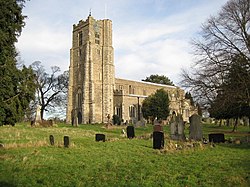Hatfield Broad Oak
| Hatfield Broad Oak | |
| Essex | |
|---|---|
 St Mary the Virgin, Hatfield Broad Oak | |
| Location | |
| Grid reference: | TL546166 |
| Location: | 51°49’38"N, -0°14’33"E |
| Data | |
| Post town: | Bishop's Stortford |
| Postcode: | CM22 7 |
| Dialling code: | 01279 |
| Local Government | |
| Council: | Uttlesford |
| Parliamentary constituency: |
Saffron Walden |
Hatfield Broad Oak is a village in north-western Essex, about five and a half miles southeast of Bishop's Stortford. The village has also been known as Hatfield Regis[1], and locally as "HBO". Near the church of St Mary the Virgin is former Benedictine priory Hatfield Regis Priory.
At around 8,800 acres, the parish is one of the largest in Essex, stretching four miles north of the village, and divided into four "quarters": Town Quarter, Woodrow Quarter, Heath Quarter, and Broomsend Quarter. At the north end of the parish lies Hatfield Forest, known for its large oak trees.[2]
The name Hatfield Broad Oak has been used since at least 1136, and the eponymous oak was mentioned in record in 1295. The forest still contains the fenced remains of a very large oak known as the "Doodle Oak", estimated as 850 years old, though it is believed to be a different tree to that which gave the parish its name. Hatfield forest is now in the possession of the National Trust.[3]
Hatfield Broad Oak was at one time a thriving market town but is now just a village. At the time of the 2001 census it had a population of 1,600.
Parish church
A Saxon church was present in Hatfield at the time of the Domesday Book. The present parish church of St Mary the Virgin is early mediæval, and has a stone tower with six bells.
The parish church was at one time part of the priory church but was rebuilt for separate parochial use towards the end of the fourteenth century and extended over the next century.[3]
The nave contains the mutilated stone effigy of Robert de Vere, 3rd Earl of Oxford, who was buried in the church in 1221. The writings belonging to the Barrington family are deposited in the north vestry; which is believed to have been part of the priory chapel. In the other vestry is a library, placed there in 1708, by Sir Charles Barrington.[2]
History
Traces of Bronze Age occupation have been found in the parish, including the Portingbury Hills mound in Hatfield forest.[3]
The settlement of Hatfield was well established by the time of the Norman Conquest and its Domesday Book population of 115 put it as the ninth largest place in Essex. At one time a royal manor recorded in the possession of King Harold I@, it fell under the possession of William the Conqueror. It was well visited for the hunting in the neighbouring forest, and its royal patronage led to its becoming known as Hatfield Regis, or King's Hatfield, partly to distinguish it from Hatfield Peverel, also in Essex.[4]
Hatfield Regis Priory was established in the Middle Ages, and dissolved under Henry VIII. By the time of the dissolution, the town had over 1000 residents.[3]
Village life
The Cock Inn, a public house, dates back to the fifteenth century.[3]
St. Mary's Church of England primary school was opened in 1816 as a National school.
Each May Bank holiday a 6-mile road race is held using a course running around the village.[5] and a 1-mile Fun Run.
Outside links
| ("Wikimedia Commons" has material about Hatfield Broad Oak) |
References
- ↑ Hatfield Broad Oak Essex through time: Local history overview
- ↑ 2.0 2.1 White's Directory of Essex, 1848
- ↑ 3.0 3.1 3.2 3.3 3.4 Victoria County History - A History of the County of Essex: Volume 8
- ↑ "The Monastery of Hatfield Regis", Rev. Alan Jones. Displayed in Hatfield Broad Oak church
- ↑ Hatfield Broad Oak 10k Road Race